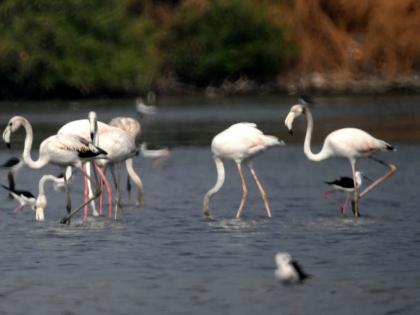Flamingos Arrive Late in Mumbai, Environmentalists Raise Concerns Over Declining Numbers
By Amit Srivastava | Updated: December 13, 2024 09:29 IST2024-12-13T09:25:07+5:302024-12-13T09:29:06+5:30
The much-awaited arrival of flamingos, Mumbai's winter-summer avian guests, has begun, sparking excitement among environmental enthusiasts. However, environmentalists note ...

Flamingo migration begins in Mumbai but with fewer birds than usual
The much-awaited arrival of flamingos, Mumbai's winter-summer avian guests, has begun, sparking excitement among environmental enthusiasts. However, environmentalists note that their numbers are significantly lower compared to previous years.
In the past few days, only about two dozen flamingos have been spotted at Vashi and the TS Chanakya wetland in Nerul, according to B N Kumar, director of the NatConnect Foundation. He expects their numbers to rise gradually over the next month.
Flamingos migrate to Mumbai around October-November and remain until the monsoon sets in, typically in June. This seasonal migration aligns with the International Migratory Bird Day, celebrated on the second Saturdays of May and October, marking the birds’ migratory cycles.
A prominent site for these birds is the Thane Creek Flamingo Sanctuary (TCFS), Mumbai's sole Ramsar site, recognized as a wetland of international importance. Despite being a haven for flamingos, their population in the region has steadily declined—from 4.5 lakh five years ago to approximately 1.3 lakh in 2022, as per statistics from the Bombay Natural History Society (BNHS).
Environmentalists have raised concerns over the deteriorating state of flamingo habitats in the Mumbai Metropolitan Region (MMR). Nandakumar Pawar, head of Sagar Shakti, highlighted the increasing pollution in Thane Creek caused by industrial and urban effluents. Despite repeated complaints, little action has been taken by the authorities, he lamented.
Three of Navi Mumbai's six wetlands—Belpada, Bhendkhal, and Panje in Uran—have been destroyed due to landfill and the blocking of intertidal water flows. Other wetlands, like the NRI wetland and DPS Flamingo Lake, have become unsuitable for flamingos, with stagnant water overrun by moss and muck.
Tragically, several flamingos died between May and June after wandering onto main roads, likely in search of food as the DPS Lake dried up due to blocked water flows caused by vested interests.
Navi Mumbai, affectionately called "Flamingo City," is now facing an existential crisis, Kumar warned.
Open in app